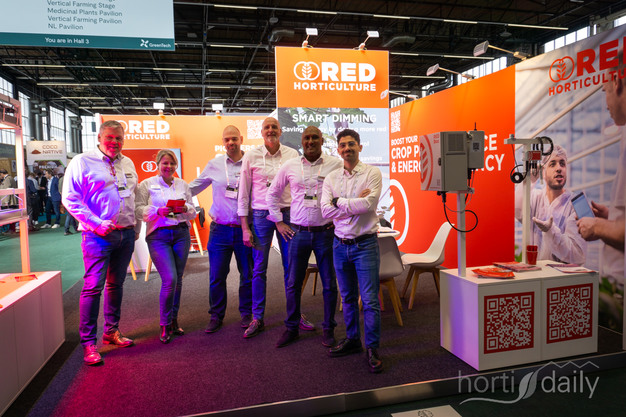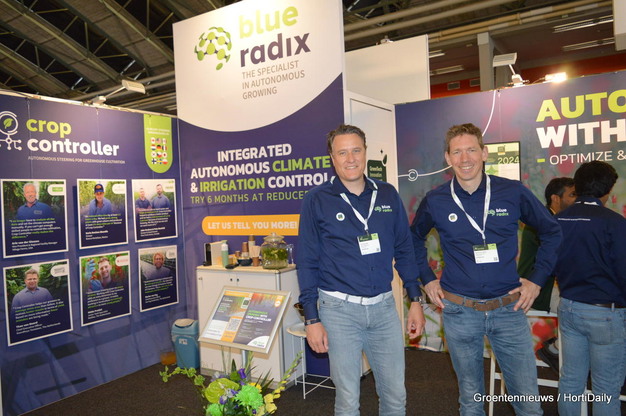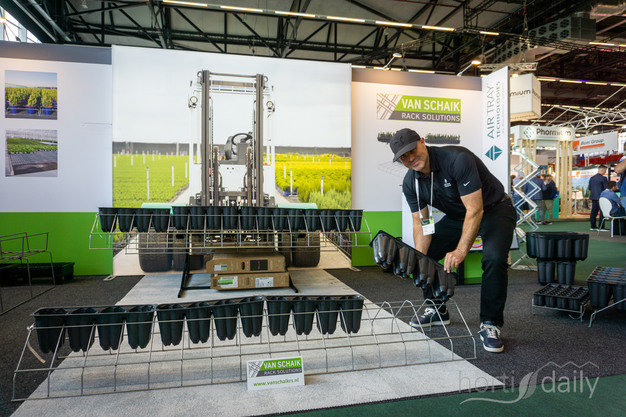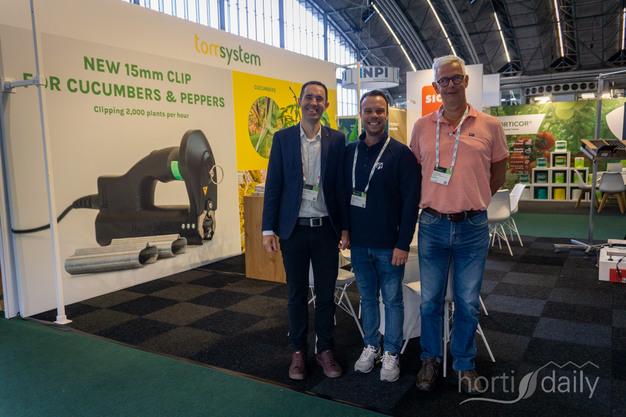GreenTech Amsterdam concluded yesterday and before we bring you our extensive photo report on Monday, we've summarized ten takeaways from the show.
 Combining sensor technology, AI and knowledge of lighting, that's how the RED horticulture team created Smart Dimming.
Combining sensor technology, AI and knowledge of lighting, that's how the RED horticulture team created Smart Dimming.
Sensors and AI
Computer vision recognition and artificial intelligence are increasingly being integrated into various technologies, improving crop condition monitoring, using light, CO₂, energy, harvest predictions, and data management. Some companies even work on completely autonomous cultivation concepts. However, several AI players have already backed out, as it remains difficult to make AI applicable in horticulture and big investments do not guarantee big successes. Data collection is not the problem; standardizing and collecting useful data is one of the key challenges. Growers are not computers, or are computers not growers?
Automating with autonomous robots, or reducing labour?
AI and robots can assist but not yet completely replace human workers. Many tasks in greenhouses can now be partially performed by robots, including leaf picking, harvesting, and disinfecting. These robots are not only available but also offer an acceptable return on investment (ROI). Human labor remains necessary to achieve 100% task completion. Automation in tasks like cutting and planting is much more advanced. In addition, there are multiple tools to reduce the labor pressure in greenhouses. These solutions offer solutions at a lower cost, and can be integrated more easily.

 Reducing labour pressure with a cost efficient way is what's the focus of David Dobos with Blackmore. Their latest collaboration helps growers to position and space raspberry plants easily.
Reducing labour pressure with a cost efficient way is what's the focus of David Dobos with Blackmore. Their latest collaboration helps growers to position and space raspberry plants easily.
LEDs
Dynamic, dimmable, steerable. The market for LED lighting is far from fully developed and new introductions also include sensors, steering, and control applications. In addition to these technical possibilities, there is of course also more knowledge about the applications of light. Think not only of far-red light but also of dynamic spectra, UV, and lights that activate white light when an employee walks down a path. This year, in addition to high-end suppliers, many Asian suppliers were present at the trade fair, providing market dynamics in terms of pricing.
Investing in CEA?
Over the last year, developments in the North American industry have slowed due to a lack of investor interest. However, starting from Q4 and continuing into the next year, the North American market for new construction is expected to pick up again, according to various suppliers. Haven't we been hearing that for a few years now? Is it wishful thinking? It doesn't seem like it. Various projects involving new or existing investors are in an advanced stage—although some will probably await the results of the elections.
 Another example of lowering labour pressure is the Tom System, which helped growers clipping easily for a number of years by now. The newest addition is the 15mm clip for cucumbers and peppers.
Another example of lowering labour pressure is the Tom System, which helped growers clipping easily for a number of years by now. The newest addition is the 15mm clip for cucumbers and peppers.
Threats
Global developments obviously influence horticulture. The wars in Ukraine and Gaza are significant destabilizers for investor enthusiasm. And there are more consequences. In recent months, we have seen strong fluctuations in the availability and costs of transportation. Another significant threat to various markets is exchange rates. For example, while there were a substantial number of Koreans at the trade fair, they face higher import costs, whereas their sales do not grow comparably. We have seen similar developments over a few years now in Mexico, another important region for greenhouse horticulture.
Don't miss out on mid-tech
Looking at many emerging markets, it's clear several of these countries will not be suitable for glasshouses, and high-tech cultivation is not on the horizon. However, Morocco's acreage has rapidly expanded and continues to do so. There is more potential in North Africa, with hydroponic cultivation starting to emerge in Egypt. Aside from Mexico, other countries in Latin and South America see the need for protected and hydroponic cultivation, for example, to protect the rapidly growing berry market from weather circumstances. Growing hydroponically seems necessary to reduce water and fertilizer usage, but education is required. Other markets not to forget: are Southeast Asia and India.
Energy
Over the past few years, growers have significantly invested in reducing their energy usage by opting for LED lamps and adding additional screens. These developments will continue, but the origin of the energy is also evolving. Growers unable to use residual heat or energy could find several battery systems on the exhibition floor, following electric boilers being the hot trend in previous years. "Batteries and buffers are going to become major trends," predicted an energy specialist.
Viruses, pests, and diseases
ToBRFV is over. Well, not completely, of course, but contrary to previous years, attention to the virus was definitely lower. Greenhouses have significantly upgraded their biosecurity protocols, and the available resistant varieties make growers feel much better equipped against the virus. Developments in crop protection include better spraying options and more efficient tools in Integrated Pest Management (IPM). A threat to the industry's development remains the approval time of new products, which specialists say is extremely slow in many countries with large greenhouse acreage.
Cannabis
Although cannabis was only a small part of the exhibition floor, it still garnered attention at the Medicinal Plants Pavilion. Exhibitors are noticeably more optimistic about the cannabis market than they were last year. This is, of course, related to recent developments in Europe. Germany promises to become an important cannabis market, and companies active there are already noticing rapid growth. The industry is also looking at the Netherlands: how will the Coffeeshop Experiment evolve? An exhibitor mentioned that he specifically came to GreenTech hoping to run into some Dutch growers. As we are accustomed to with cannabis, it will take time to see how the market will truly develop. But for now, the positivity in the industry is greatly appreciated.
Vertical farming
Notably, last year a lot of new startups focusing on vertical farming software popped up that focused on farm management solutions, whereas this year they were barely or nowhere to be found. As for the vertical farming market, there has been a significant shift from end-to-end suppliers, rather than focusing on more 'modest', niche, or research-based projects. Some mentioned that medicinal and pharmaceutical production is growing as vertical farms allow for an ultra-controlled environment.
Roaming on the exhibitor floors, some suppliers mentioned have pivoted to R&D projects for customers only as larger projects are put on hold. Besides that, instead of opening new offices across borders, there have been various announcements of partnerships to boost products and solutions overseas to double down on efficient use of resources. Last but not least, the market is still growing steadily with numerous projects currently under construction in the Middle East and Southeast Asia in particular. Despite the turmoil in the Singapore market, which we will very soon elaborate further on, also here projects are finalizing construction.
